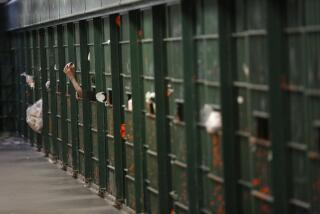Judges take on prison overcrowding
SAN FRANCISCO — After years of failed attempts by California officials to rein in their overburdened prison system, three white-haired federal judges appear determined to find the solution themselves in a lofty courtroom here.
The judges are presiding over a trial in two long-running lawsuits intended to discover whether an overcrowding crisis is the prime cause of medical and mental healthcare so poor that it violates inmates’ constitutional rights; if it is, they will decide how to fix the problems.
Although the trial is only halfway over, the judges are speaking and acting as if they have already decided to take action against the state. Now they seem only to be searching for answers on precisely what action to take and have openly contemplated an order to release prisoners and impose a cap on the state prison population.
“The question from our point of view is developing an effective set of orders that will protect society . . . and ensure there is a constitutionally sufficient level of care,” explained U.S. District Judge Lawrence Karlton, who said later that the trial wouldn’t be needed “if the state were to wake up and start behaving in a rational way.”
A ruling is expected early next year. Lawyers for Gov. Arnold Schwarzenegger, state lawmakers and local law enforcement officials say they will appeal any decision to release prisoners directly to the U.S. Supreme Court.
Inmates’ attorneys seek an order to remove 52,000 inmates over two years from a $10-billion-a-year state system that incarcerates more than 170,000 people in 33 state prisons and in fire camps, drug programs and institutions in other states.
Some experts think the state could dramatically reduce overcrowding without a public safety risk if it stopped a revolving door of tens of thousands of offenders who are repeatedly sent from their communities to prison for a few months at a time on parole violations and low-level crimes.
“We catch people and we release them,” Jeanne Woodford, a former corrections chief under Schwarzenegger and an ex-warden at San Quentin State Prison, told the judges. “We don’t do anything for them while they’re incarcerated, and we’re really just disrupting their lives over and over again, and it really doesn’t add to public safety.”
Woodford and others testifying for the inmates suggest keeping low-level offenders in less expensive alternatives such as county jail or rehabilitation programs.
The jurists, who include U.S. District Judge Thelton Henderson and 9th U.S. Circuit Court of Appeals Judge Stephen Reinhardt, have interrupted attorneys for both sides to question witnesses about the cost and effect on the public of various steps they might take.
They engaged Stanislaus County Probation Chief Jerry Powers about what would happen if the state were forced to let a car thief out of prison two months early. Would extra time on the street allow him to steal more cars? Or would he steal the same number of cars before getting caught no matter when he was released? Answer: It depends on the skill of the thief.
The state’s lawyers say there has been improvement in the prisons. And the state contends the flaws, including a lack of access to care and treatment space and incompetent doctors and nurses, can’t be tied primarily to overcrowding.
A former medical official in the Florida prisons who studied California’s system testified that there used to be a “culture” that prioritized keeping institutions secure over providing healthcare, but he said that changed once Henderson appointed a prison medical czar in 2006.
“There clearly has been a shift,” the doctor, David Thomas, said via video from his home state. He also said it is acceptable to treat inmates in a bathroom to preserve patient confidentiality, as California prison doctors have done for lack of space.
“It’s not necessarily the best way to do things, but certainly one has to be creative,” Thomas said.
The state has acknowledged that some prisons house twice as many inmates as they were designed for because of years of tough-on-crime initiatives and extensive legislation to lengthen criminal sentences. Although many experts have proposed solutions, little has changed. Now the state is fighting J. Clark Kelso, the court’s medical czar who wants to spend $8 billion to build inmate healthcare facilities.
Meanwhile, inmates have pushed the cases that put the judges in a position to make state policy. Federal law requires the judges to consider the effect on public safety of whatever they choose, and the state has sought to draw a link between California’s stiff criminal penalties and recent reductions in crime.
But James Austin, a criminologist, testified that other states have reduced sentences and prison population and seen drops in crime as well. There would be no added risk if California shortened prison terms as other states have done, he said.
“In Indiana, if you get your high-school degree, you get 12 months off,” he said. “If you get a college degree, you get two years off. The whole idea here is to provide that carrot for prisoners. . . . You lower the risk, you lower the length of stay, you lower the cost for that system.”
--
More to Read
Sign up for Essential California
The most important California stories and recommendations in your inbox every morning.
You may occasionally receive promotional content from the Los Angeles Times.










